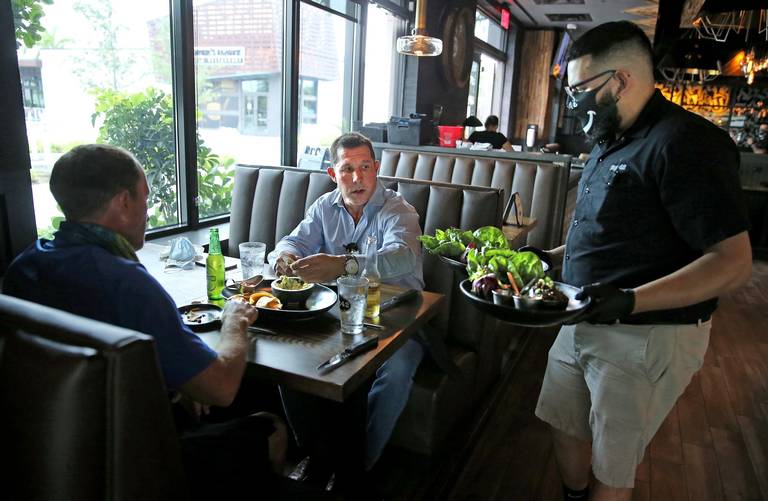As hospitality and restaurant reporters cover the next phase of pandemic response, they are learning how their own jobs are changing and what’s staying the same.
Like many other beat reporters, they’ve seen that source building and relationship skills are key to covering a community, especially during a crisis. But supplying context in such a novel time has driven up the need for good data reporting. It has also made some reconsider the role that restaurant reporters play in a city.
Jane Wooldridge is the business editor at the Miami Herald. Her team is faced with the same task all journalists are now: taking a deeper look at how the pandemic is affecting their communities, as opposed to the early days of breaking stories and covering cases. They’re covering several sectors, such as local shops, malls, and the dining scene. But their location offers a unique industry to cover, too: the cruise industry.
South Florida is home to some of the busiest cruise ports in the world. The team usually covers cruises from a customer perspective, Wooldridge said. The cruise companies themselves aren’t headquartered in the state; they’re usually international.
Amid the pandemic, that coverage has broadened. Reporter Taylor Dolven has written extensively about cruise ship workers. The stories have included an investigation revealing 100,000 staff members trapped at sea, many without pay. Another looked at how cruise lines were returning their international workers to their home countries, and how those processes came under fire.
“Taylor did that, in large part, by good old-fashioned reporting,” Wooldridge said.
It meant making contacts with workers, their families and passengers. It meant keeping track of verifiable records like captain statements or information bulletins released to workers.
Similarly, covering businesses such as restaurants has highlighted how important community ties are. Wooldridge said that her team, which is at a city-based newspaper, has an advantage.
“Some of us have been here a really long time,” she said. “We know people because we know them. We live here. I would say that is the No. 1 key element, but the other key element has been following data.”
The Miami Herald isn’t a stranger to data reporting. They have a dedicated data team and ensure their reporters can attend trainings on it. They have transparency protocols that require their staff to explain their methodology and share raw data.
The pandemic has given the paper even more opportunities to develop that tool set. In addition to more scientific data, the paper has conducted its own research, such as a survey of local businesses and their outlook post-pandemic.
“There are simpler ways to create sentiment surveys,” Wooldridge said. “We don’t pretend that this is a statistically accurate methodology.”
The team might not be calculating a p-value, but they’re still ensuring it’s a good representation of the community, Wooldridge said. That business survey had 352 respondents. Members of the city’s main chamber of commerce and its minority chamber of commerce were proportionately represented among the respondents.
“80% have fewer than 10 employees,” she said. “Well, that’s what our county looks like.”
Wooldridge said that the Herald’s food editor, Carlos Frias, had already been moving away from restaurant reviews and more toward writing features about people in the restaurant community. That laid the foundation for the work he’s been doing, she said, which has included many restaurants pivoting to carry-out only or opening grocery sections.
“Restaurants have obviously been one of the worst-hit sectors here in Miami and south Florida,” she said. “He had those relationships. He had everyone’s cell phone number.”
Matthew Odam, the Austin American-Statesman’s restaurant reporter, has seen a similar shift.
Odam compared the industry finding out about and dealing with those major blows to seeing and putting out a fire.
“Now we’re just in clouds and clouds of smoke that seem kind of endless,” he said.
He said larger outlets usually have at least one person reporting on restaurants and another person writing reviews. At the Statesman, it’s just him. He estimated the ratio of feature stories to critic pieces was about 80-20 before the pandemic hit, but that’s likely about to drop.
“I know as reporters, we’re not supposed to have feelings,” he said with a laugh. “But it’s been hard to watch an industry that I care about, and people that I’ve watched grow and work tirelessly to build culture in our city take such a financial hit.”
He’s covered confusion over PPP loans, how servers have had to file for unemployment, how people are working with landlords. He’s also covered the closing of restaurants that have operated for decades. The restaurant industry in Austin, like many in the hospitality realm, depends on the city’s festival season. They have taken a huge hit with events such as South by Southwest being canceled.
He said that his attention has been contextualizing restaurants in the city’s development landscape and focusing on the human element.
“It’s really a cultural criticism job to a large degree,” he said. “Helping people see the city through the lens of restaurants.”
As the recovery from the pandemic continues to take shape and the industries reporters cover continue to undergo significant changes, journalists will have to continue their work adapting.
Catherine Sweeney is a freelance reporter covering COVID-19 for Poynter. You can reach her at catherinejsweeney@gmail.com or @CathJSweeney on Twitter.






